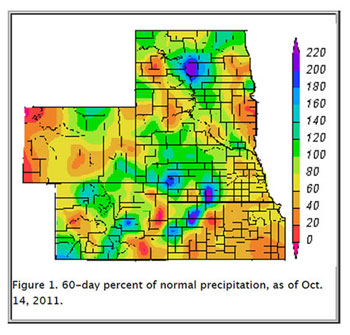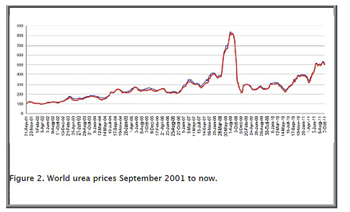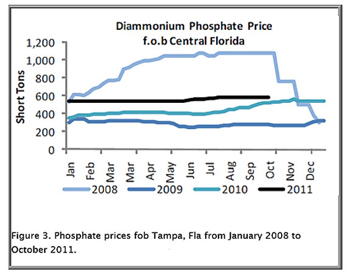Recent rains across the state should provide great conditions for sampling after harvest (Figure 1).
This year has produced a range of precipitation. Varying corn yields due to N leaching, disease or weather damage produce variability in soil residual nitrate-N.

Because soil nitrate is mobile, soil sampling is the only reliable way to determine what is left in your soil. Soil samples for nitrate should be taken to at least a three-foot depth for next year’s corn crop. View soil management tools at http://cropwatch.unl.edu/web/soils.
Nitrogen prices have continued to climb since spring 2010 Figure 2. Prices for urea in Figure 2 are averaged over several sources calculated weekly, giving equal weight to prices published by major trade publications for granular urea FOB vessel from the Middle East, southeast Asia, the U.S. Gulf and Latin America.

Retail urea prices are approximately $600 per ton plus or minus $25 per ton, depending on your area. Prices for spring should be back down around $570 per ton, which is about $0.60 per lb of N.
Currently, UAN solution is also as high in cost as urea per pound of N. Ammonia continues to increase, especially on world markets due to production problems in the Caribbean. Prices range from $800 per ton to $875 per ton depending on when your dealer bought its supply. If production problems are fixed, spring prices should be around $750 or less per ton ($0.45 per lb of N).
Information from your soil tests plus fertilizer prices and expected selling price for your corn are used in calculating the recommended nitrogen rate. Current nitrogen fertilizer prices (ammonia lower cost, urea or UAN higher) range from $0.50 to $0.70 per pound of N.
Because pricing depends on an individual’s marketing plan, a range of fertilizer and corn prices can be used in the spreadsheet to look at the most profitable N recommendations. With corn in the $6 to $7 range and nitrogen in the $0.50 to $0.70 range, the recommended N rate for 200 bu/ac corn would range from 185 to 240 lb N per acre.
Phosphorus
Phosphorus prices for 18-46-0 (DAP) have increased significantly since early 2010 (Figure 3) but have leveled off recently. Next spring this product is expected to be over $700 per ton at the farm level. Ammonium polyphosphate (10-34-0) prices currently are at a premium compared to dry.
Manure Nutrients
High fertilizer prices increase the value of manure. Fall and spring soil sampling are not useful in predicting the nutrients available from recent manure application, due to the extended period when manure releases its nutrients.
Nitrogen availability can be estimated based on when the manure was applied, the application rate, the concentrations of organic and ammonium-N, and the application method.
For more information on how this is determined, view the UNL webcast, Manure Application and Nutrient Management, at https://connect.extension.iastate.edu/p88906821/?launcher=false&fcsContent=true&pbMode=normal.
To take full advantage of manure N, sidedress some or all fertilizer N; use the pre-sidedress nitrate test to determine the rate. Other manure nutrients such as P and Zn are generally applied in sufficient amounts with a uniform manure application to fully meet crop requirements for two or more years.
Recommendations
Take soil samples this fall as the first step to producing a profitable crop for 2012. The best way to minimize fertilizer expenses and maximize profit is to only put on the nutrients you need.
Concentrate on the nutrients that have been shown to produce yield increases. Products and nutrients that don’t have a research-based recommendation should be tested in small areas before being used extensively. FG
—University of Nebraska–Lincoln Cropwatch newsletter, October 2011
Figure 1 courtesy of High Plains Regional Climate Center. Figure 2 courtesy of Fertilizerworks.com, Basket Price. Figure 3 courtesy of Cleveland Research Company.










